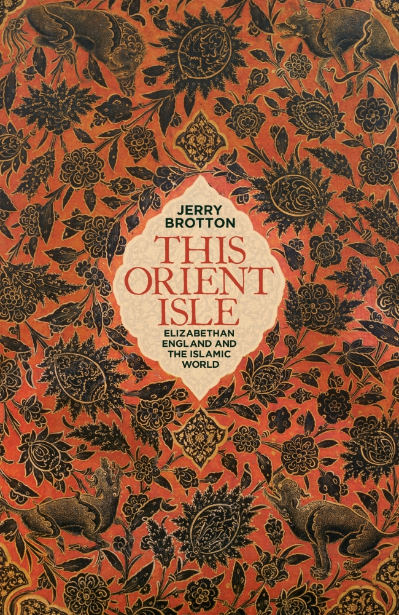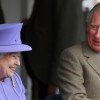Book Review – Elizabethan England and the Islamic World
written for The Times, 19th March 2016

Image Source: Penguin Books
THIS ORIENT ISLE: ELIZABETHAN ENGLAND AND THE ISLAMIC WORLD BY JERRY BROTTON, ALLEN LANE, 384pp, £20.
by Jerry Brotton
Every TV viewer is familiar with the grotesque image of the aged Elizabeth I’s blackened teeth, from Bette Davis to Anita Dobson. Jerry Brotton starts his story of Elizabethan England’s interaction with the Muslim world by introducing us to Abd al-Wahid bin Masoud bin Muhammad al-Annuri, Moroccan ambassador to London in 1600. As the envoy looks at the Virgin Queen’s rotten gnashers we see, through his eyes, 40 years of Moroccan sugar exports wreaking their havoc.
If Brotton sometimes overstates his case for the Islamic world’s centrality to Elizabethan court politics, this is a vivid, significant work of scholarship. Trade with the Islamic world was well under way even as Elizabeth ascended her insecure throne in 1558. By the 1560s England was importing 250 tons of sugar a year “from the kingdom of Morocco in Barbary”, along with almonds and dates.
What Morocco, and then the Ottomans, wanted in return was English cast-iron weaponry. Spain’s diplomats noted with alarm that ships left England not only laden with wool and linen, but “pikes and armour” and “all sorts of munitions of war”. This demand for weaponry was to be the Mediterranean’s greatest opportunity for Elizabeth’s new venture economy.
Elizabeth was happy to find points of ecumenical agreement with her Muslim allies, as long as they served her purposes. The Sunni practices of the Ottoman Turks, in particular, appealed to European Protestants “with its refusal to worship icons and its venerating of a holy book, as a faith with which it could do business”. (Purely convenient, then, that Elizabeth and Murad III shared a common enemy in the Catholic Philip II of Spain.) Not that Elizabeth would have recognised the words “Sunni” or “Shia” — or even “Muslim”, first used in print in 1615. Elizabethans referred to Mahometans, Saracens or Turks, a catch-all for all Muslims.
Other Europeans picked their trading partners with similar niceness: in 1502 the Venetian spy Constantino Laschari enthusiastically described the Shia faith of the Persian Safavid court as “Catholic in their way”. Sunni or Shia, though, selling cannon to a Muslim ruler was beyond the pale for any Christian queen. So she did it covertly. Much of Brotton’s narrative of Mediterranean arms dealing reads like a recent episode of le Carré’s The Night Manager: spies, subterfuge and weapons of mass destruction.
The ruse couldn’t last. In August 1578, Sebastian, King of Portugal, lay dead on the battlefield of El-Ksar El-Kebir, his force smashed apart by English cannonballs shot at them by Moroccan Muslims.
The repercussions were immediate: Elizabeth, embarrassed, finally banned her privateers from the arms trade and distanced herself publicly from Morocco; its new king, whose pro-English elder brother had not lived to see his victory, was busy securing his power and had little time for a distant Christian island.
The old divisions — Christians against Muslims, Frank against Moor — had reasserted themselves. Elizabeth’s intelligencer, Sir Francis Walsingham, turned his attention to a fledgeling relationship with the Ottoman Empire, but it would take decades before open friendship with either nation was ever on a firm footing.
Elsewhere, Anglo-Islamic relations were more genteel. The middle classes went mad for Turkish carpets. Among the aristocracy, the Earl of Leicester owned more than 80, and John, Lord Lumley, more than a hundred “Turkey carpets of silk”. Bess of Hardwick — who had merely 46 — tried to outclass them with a wall-hanging depicting Muhammad on the point of conversion to Christianity, although it’s hard to read this home décor in distant Derbyshire as a response to new developments in Anglo-Islamic diplomacy when those developments were, as Brotton admits, top secret.
Meanwhile, imports from Barbary, Turkey and Muscovy changed our tastes; the English drank sweet wines or added aniseed, nutmeg, turmeric and pistachios to their diet. At one point, the nation’s merchants were importing 2,300 tons of currants a year from the Ottoman-controlled Greek islands.
Cultural exchanges with Islam were part of the warp and weft of the Elizabethan English experience. Plays such as Robert Wilson’s Three Ladies of London portrayed Muslim judges (and Jewish merchants) as men of integrity according to the precepts of their own religion; the clumsy but well-intentioned Mahomet and his Religion dreams of healing the schism between Sunni and Shia in the name of common humanity.
For every Three Ladies of London, there was a Lust’s Dominion, or The Lascivious Queen, a pornographic vision of the predatory Muslim avenging himself on equally bloody Spaniards; the spectre of Spanish-Moor miscegenation loomed large in the English imagination. Beneath such plays lurked deep anxiety about the ease with which a Christian might “turn Turk”, only one generation after mass conversion from Catholic to Protestant doctrine (and briefly back again).
Brotton, professor of Renaissance studies at Queen Mary University of London, reads Elizabethan playwrights with a sharp eye and a dry sense of Tudor irony. It’s a shame we have to slog through some of the denser trade negotiations of the 1570s to get to the flowering of performance culture in the 1590s. Not every promise is fulfilled. Brotton’s introduction gives us a vital sense of Ambassador al-Annuri, who has long been a romantic figure in early modern history thanks to his being the first Muslim to have been painted in Britain. His portrait hangs in the National Portrait Gallery.
There is little evidence, however, for Brotton’s early insistence that Othello was inspired by al-Annuri — as opposed to the plethora of other literary and political images of Moors in Europe, to which Brotton has rightly drawn our attention elsewhere.
Dubious gentlemen adventurers are a staple of This Orient Isle. Thomas Stukeley, “a ruffian, a riotous spendthrift and a vapourer”, jacked in collusion with Irish rebels for piracy in the Med, only to wind up in the King of Portugal’s army in Morocco in 1578. He suffered an ignoble end:“There came a piece of artillery that took off both his legs; and so he ended his days,” one contemporary said. “He might not have ‘given a fart’ about Elizabeth, but it may have been one of her cannonballs that killed him,” Brotton writes.
John Symcot, a bumptious buccaneer, managed to upset the many English merchants already quietly trading iron, lead and tin in Morocco by using his royal licence as if it were a monopoly and detaining his fellow-countrymen’s ships. Peter Baker, a servant of the Earl of Oxford, managed to scotch the Ottoman alliance through freelance piracy just as it was finally getting off the ground in 1581, hijacking what looked like an Ottoman ship, only to discover it loaded with Greek goats’ hair.
One of the gems of Brotton’s book is the merchant-adventurer Anthony Jenkinson, “a great pioneer of Elizabethan travel”, who had spent the years of Mary Tudor’s reign complaining by letter from Aleppo, Persia and Uzbekistan that his heavy English cloth was “not vendible” in the hot climes around which he found himself lugging it. He gave to Elizabeth an enslaved Tartar girl (“my wench Aura Soltana”), “the first recorded Muslim woman to enter the Tudor kingdom”.
Brotton has set out to prove that Islam’s relationship with Britain has been for much of our history been — and still can be – deeply integrated and mutually prosperous. “Those involved did not seem to think they were playing out some profound clash between civilisations,” he asserts, swiping discreetly at pundits such as Douglas Murray or Ayaan Hirsi Ali.
This flowering between Elizabeth’s England and the Islamic world wasn’t to last. With the reign of James I came rapprochement with Spain — immediately, consorting with Philip III’s rivals in the Mediterranean became a no-no.
A painting in the National Maritime Museum depicts the Somerset House conference of 1604, at which both Spanish and English finally put paid to Ottoman alliances in Europe. The table is covered by a Turkish carpet. As Brotton artfully and learnedly demonstrates — over the 300 pages of this impressive, enjoyable book — it’s all in the detail.






